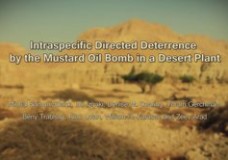Seed Dispersal Under the Threat of Mustard Bomb – Michal Samuni-Blank (2012)
Plants evolved diverse ways to disperse their seeds using animals. To give a few specific examples Long-wattled umbrella birds, Toucans and fruit eating bats are known for effective dispersal of palm tree seeds by eating the fruits. These dispersers regurgitate or defecate seeds after flying far away. On the other hand, most fruit eaters are also seed predators. Unlike birds and bats other animals such as agoutis, monkeys, peccaries and tapirs can chew and destroy the very same palm seeds. […]

















Recent Comments